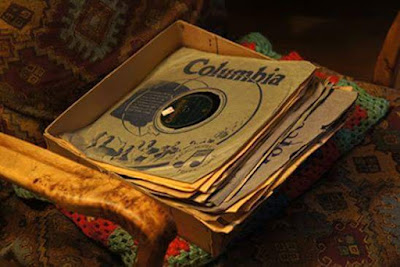1. Albert Campbell - Dreaming (3701). Steve Porter - Flanagan At The Vocal Teacher's (3705). Standard Talking Machine Company 1907.
2. All Star Trio - Poor Little Butterfly Is A Fly Gal Now (18641-A). Fluffy Ruffles (18641-B). Victor Records 1919.
3. American Quartet - When You Wore A Tulip (17652A). Peerless Quartet - The Red, White and Blue (17652-B). Victor Records 1914.
4. Andre Benoist - Old Black Joe (50292-L). Valse In E Flat (50292-R). Edison Records 1915.
5. Anna Case - Old Folks At Home (83059-L). Annie Laurie (83059-R). Edison Records 1916.
6. Billy Murray - When Tony Goes Over The Top (18510-A). Arthur Fields - Good Morning Mr. Zip-Zip-Zip! (18510-B). Victor Records 1918.
7. Charles Hart, Elliot Shaw and The Calvary Choir - Shall You? Shall I? (80529-L). Charles Hart & Elliot Shaw - Is My Name Written There? (80529-R). Edison Records 1919.
8. Chatauqua Preachers Quartette - Softly Now The Light Of Day (39476). Let The Lower Lights Be Burning (39477). Standard Talking Machine Company 1914.
9. Chester Gaylord - Love's Old Sweet Song (80613-L). Edna White - Recollections of 1861-65 (80613-R). Edison Records. 1920.
10. Collins and Harlan - Just Help Yourself (3695). Cal Stewart - Uncle Josh Joins The Grangers (3706). Standard Talking Machine Company 1907.
11. Collins and Harlan - On The 5:15, United Talking Machine Company (39697). Ruff Johnson's Harmony Band (39698). Standard Talking Machine Company 1915.
12. Columbia Quartette - War Song Hits - Part I (A2428). War Song Hits - Part 2 (A2428). Columbia Records 1918.
13. Dabney's Band - Beautiful Ohio (A-12081). Hindustan (B-12081). Aerolian Vocalion 1919.
14. Edison Band - Medley Of American Patriotic Airs (50212-L). Medley Of American War Songs (50212-R). Edison Records 1914.
15. Edison Quartet - The Star Spangled Banner (80172-L). America (My Country 'Tis Of Thee (80172-R). Edison Records 1914.
16. Edison Quartet - He Lifted Me (80204-L). Let The Lower Lights Be Burning (80204-R). Edison Records 1914.
17. Edward Hamilton - Just Like The Rose (4725). Charles Hart & Elliot Shaw - Let The Rest Of The World Go By (4726). Emerson Records 1919.
18. Elizabeth Spencer & Henry Burr - You're Still An Old Sweetheart Of Mine (18590-A). Lewis James and Shannon Four - The Gates Of Gladness (18590-B). Victor Records 1919.
19. Elizabeth Spencer - Call Me Your Darling Again (80098-L) 1916. Metropolitan Quartet - Annie Laurie (80098-R). Edison Records 1914.
20. Elizabeth Spencer & Thomas Chalmers - Abide With Me (80276-L). John Young & Frederick Wheeler - When The Roll Is Called Up Yonder (80276-R). Edison Records 1915.
21. Ernest L. Stevens Trio - If I Had My Way Pretty Baby (51026-L). Red Mon Waltz (51026-R). Edison Records 1922.
22. Esther Walker - How Sorry You'll Be (Wait'll You See) (18657-A) Nov. 18, 1919. Billy Murray - He Went In Like A Lion And Came Out Like A Lamb (18657-B). Victor Records Jan. 2, 1920.
23. Frank Ferera/Anthony Franchini - Bright Moon (19088-A). Hawaiian Nights (19088-B). Victor Records 1920.
24. Fred Bacon - Old Black Joe (50351-L) 1916. Massa's In De Cold, Cold Ground (50351-R). Edison Records 1915.
25. Fred Van Eps - Medley Of Southern Melodies (51145-L) April 1923. Darkey's Dream and Darkey's Awakening (51145-R) 1922. Edison Records.
26. Geoffrey O'Hara - Send Me A Curl (18441-A). Lewis James and Shannon Four - All Aboard For Home Sweet Home (18441-B). Victor Records 1918.
27. Happy Six - I'm Nobody's Baby (79798). Cherie (79802). Columbia Records 1921.
28. Helen Clark & George Wilton Ballard - In The Old Sweet Way (50534-L). I'm Forever Blowing Bubbles (50534-R). Edison Records 1919.
29. Henry Burr - Are You From Heaven (18435-A) 1917. Sterling Trio - Give Me The Right To Love You (18435-B). Victor Records 1919.
30. Henry Burr - Then You'll Remember Me (414). Mrs. Stewart Holt and Frank C. Stanley - 'Tis But A Little Faded Flower (3402). Standard Talking Machine Company 1910.
31. Henry Burr - Throw Out The Life Line (3205) 1905. Stanley and Burr - What A Friend We Have In Jesus (3756). Talking Machine Company 1907.
32. Henry Burr - Abide With Me (A236). Where Is My Wandering Boy Tonight (A236). United Talking Machine Company 1908.
33. Henry Burr and Peerless Quartet - Broadway Rose (18710-A). Sterling Trio - Mother's Lullaby (18710-B). Victor Records 1920.
34. Henry Burr - That Wonderful Mother Of Mine (18524-A) 1919. Charles Anthony/Lewis James - Salvation Lassie Of Mine (18524-B). Victor Records 1919.
35. Henry Burr - Just A Baby's Prayer At Twilight (18439-A). Percy Hemus - On The Road To Home Sweet Home (18439-B). Victor Records 1918.
36. Irving Kaufman - Oh! Oh! Oh! Those Landlords (78445). Billy Murray - And He'd Say Oo-La La! Wee-Wee (78536). Columbia Records 1919.
37. James Craven - Georgia Rose (2172-A). Ernest Hare - I Want My Mammy (2172-B). Brunswick Records 1921.
38. Jaudas' Society Orchestra - The Missouri Waltz (50428-L). Poor Butterfly (50428-R). Edison Records 1917.
39. Joe Hayman - Cohen Telephones the Health Department (29685). Prince's Orchestra - Serenade (46167). Columbia Records 1915 R.
40. John Steel - Tell Me Little Gypsy (18687-A). The Girl Of My Dreams (18687-B). Victor Records 1920.
41. Joseph C. Smith's Orchestra - Alice Blue Gown (18700-A). Tripoli (18700-B). Victor Records 1921.
42. Kelly Harrell - Hand Me Down My Walking Cane (20103A). My Horses Ain't Hungry (20103B). Victor Records 1914.
43. Lewis James and Peerless Quartet - Smile And The World Smiles With You (18545-A). Sterling Trio - That Tumble Down Shack In Athlone (18545-B). Victor Records 1919.
44. Louise, Ferera and Greenus - Kawaihau Waltz (77798). Hawaiian Breezes (77884). Columbia Records 1918.
45. Maggie Teyte - Ma Curly-Headed Babby (82159-L). I'se Gwine Back To Dixie (82159-R). Edison Records 1919.
46. Metropolitan Quartet - I Will Sing Of My Redeemer (80300-L). I Love To Tell The Story (80300-R). Edison Records 1914.
47. Metropolitan Quartet - Come Where The Lillie's Bloom (80321-L) 1915. Thomas Chalmers - My Old Kentucky Home, (80321-R). Edison Records 1914.
48. Metropolitan Quartet - The Little Old Log Cabin In The Lane (80484-L) 1918. Betsy Lane Shepherd - I'll Remember You, Love In My Prayers (80484-R). Edison Records 1917.
49. Metropolitan Quartet - Darling Nellie Gray (80010-L) 1914. Elizabeth Spencer & Vernon Archibald - Ever Of Thee I'm Fondly Dreaming (80010-R). Edison Records 1920.
50. Orpheus Male Chorus - Dixieland Memories No. 2 (80395-L). Dixieland No. 1 (80395-R). Edison Records 1917.
51. Pale K. Lua and David Kaili (Irene West Royal Hawaiians) - Cunha Medley (17774-A). Hula Medley (17774-B). Victor Records 1915.
52. Rae Eleanor Ball; Jessie L. Deppen - Havana Moon (50857-L). Wonderland Of Dreams (50857-R). Edison Records 1921.
53. Sam Ash - On The Road To Happiness (46130). Reed Miller and Frederick Wheeler - Keep The Home Fires Burning (46135). Columbia Records 1915.
54. Sam Ash - When I Leave The World Behind (45647). Herbert Stuart - When The Lusitania Went Down (45660). Standard Talking Machine Company 1915.
55. S.C. (Steve) Porter [Chimes] - Safe In The Arms Of Jesus (A239) 1902. Henry Burr - Savior Lead me Lest I Stray (A239). Standard Talking Machine Company 1905.
56. Selvin's Novelty Orchestra - Dardanella (18633-A). My Isle Of Golden Dreams (1863-B). Victor Records 1919.
57. Sibyl Sanderson Fagan - L'Ardita - Magnetic Waltz (80453-L). Sibyl Sanderson, Fred Hager and Harvey Wilson - Sundown In Birdland (80453-R). Edison Records 1918.
58. Sousa's Band - U.S. Field Artillery March (18430-A). Liberty Loan March (18430-B). Victor Records Dec. 21, 1917.
59. S.W. Smith, U.S.N. And Bugle Squad - U.S. Army Bugle Calls Pt. 1. (50452-R). U.S. Army Bugle Calls Pt. 2 (50452-L). Edison Records 1918.
60. Thomas Chalmers - Nearer My God To Thee (50002-L) July 21, 1913. Elizabeth Spencer & Frederick Wheeler - Dreams Of Galilee (50002-R). Edison Records 1915.
61. Thomas Chalmers - Beulah Land (80549-L). Fred East & Lewis James - Only A Step To Jesus (80549-R). Edison Records 1920.
62. Thomas Chalmers - The Palms (82055-L). O Holy Night (82055-R). Edison Records 1914.
63. Thomas Chalmers - Recessional (82133-L). Battle Hymn Of The Republic (82133-R). Edison Records 1917.
64. Toots Paka Hawaiian Company - Kilima Waltz (4795). Hilo March (4798). Emerson Records 1919.
65. Vasa Prihoda - On Wings Of Song (82236-L). (a) Songs My Mother Taught Me (b) Poem (82236-R). Edison Records 1921.
66. Venetian Instrumental Quartet - On The High Alps (50065-L) 1914. American Symphony Orchestra - Wedding Of The Winds Waltzes (50065-R). Edison Records 1912.
67. Waikiki Hawaiian Orchestra - One, Two, Three, Four Medley (50455-L) 1917. Ford Hawaiians - Ellis March (50455-R). Edison Records 1916.
68. Walter Van Brunt - Hickey Dula (50348-L). Collins and Harlan - On The Hoko Moko Isle (50348-R). Edison Records 1916.
69. Walter Van Brunt - Don't Bite The Hand That Feeds You (50357-L). Billy Murray - Are You From Dixie ('Cause I'm From Dixie Too) (50357-R). Edison Records 1916.
70. Walter Van Brunt & Elizabeth Spencer - On The Banks Of The Brandywine (80160-L). I'll Take You Home Again Kathleen (80160-R). Edison Records 1914.
71. Whitney Brothers Quartet - Home Of The Soul (16372-A). Stanley and Burr - I Am Praying For You (16372-B). Victor Records 1912.












